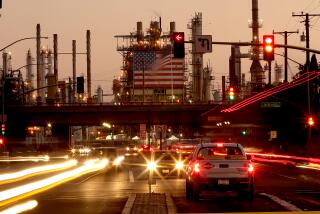High-Octane Demand Expected to Keep Gasoline Prices Well Above $1
- Share via
NEW YORK — Strong demand for higher octane gasoline, sparked by a resurgence of high-powered performance cars in the United States, is expected to keep prices for premium unleaded gasoline well above $1 a gallon nationwide into next year, industry analysts said.
“Some of (the increased demand) may be that gasoline is relatively cheap and with the trend toward so-called muscle cars there’s been a strong marketing campaign for improved octane,” said Dennis Winters at DRI Energy in Massachusetts.
Experts also attribute the higher price for premium gasoline of 92 octane or above to a squeeze on supplies triggered by a limited quantity of octane enhancers and dwindling refinery capacity in the United States.
According to Trilby Lundberg, publisher of the Lundberg Letter, the nationally weighted average price of premium gasoline, including taxes, was $1.109 a gallon for the week ended Oct. 21. The weighted average price for regular unleaded gasoline for the same period, including taxes, was 96.30 cents.
Lundberg’s average price combines full and self-service prices at roughly 12,000 U.S. retail locations.
In the New York harbor cash market, premium gasoline has held a steady margin in the past few months of about 15 cents over the unleaded futures contract traded on the New York Mercantile Exchange.
Traders said the differential between high-octane motor fuel and regular unleaded grade shows no sign of narrowing as motorists push for greater quantities of high-octane fuel to power larger, more powerful cars.
With prices for gasoline well below the record levels of a decade ago, motorists appear willing to spend more money to boost performance, industry experts said.
Since the federal government’s ban on lead additives in motor fuel was initiated in 1985, demand for alternative octane enhancers has risen sharply, industry sources said.
“With demand where it is and supplies tight after Shell’s refinery exploded, the price of premium should stay well above $1 a barrel through the winter,” said one oil trader.
Royal/Dutch Shell’s Shell Oil Co. lost nearly one-fifth of its gasoline production when a fire and explosion ripped apart a catalytic cracking unit at its Norco, La., plant in May. Although the company partially restored production at some of the units, the cat cracker--a key supplier of high octane products--will have to be replaced, company officials said.
“Industrywide, there have been a couple of bumps in refining capacity this year,” said Bob McKeehan, general manager of marketing at Amoco. “Until that gets back on stream, there can be some supply problems,” he said.
Moreover, the number of refineries in the United States has dropped to 213 from 324 in 1981, according to data from the American Petroleum Institute, an industry trade group based in Washington.
In addition to dwindling U.S. refinery capacity, refiners are also faced with a difficult choice regarding the allocation of petroleum additives to boost octane.
Some feedstocks such as toluene and benzene, which were once affordable octane boosters, are rising in value because those products can also be used to supply a booming petrochemical industry.
“Right now, petrochemicals are the hot ticket, so the additives that would be used to boost octane are going to the petrochemical industry,” said one Houston-based trader.
Alan Leard, product engineer at Amoco Corp., said most of the cars that need the high-octane fuel are getting it, despite claims that supplies are tight and that premium gasoline is going for premium prices.
About 80% of the nation’s cars run at peak performance when using regular grade or mid-grade gasoline with octane ratings of 87 and 89 respectively, Leard said.
A greater percentage of today’s cars are equipped with so-called knock sensor computers which “read” the octane content of gasoline and adjust performance accordingly. Roughly 25% of the present fleet have knock sensors, while 35% of 1989 models are equipped with the devices, Leard said.
Analysts said that premium grade’s market share has grown to roughly 30% of the U.S. gasoline pool and that the refining industry will be hard-pressed to produce more than 30% to 35% of high-octane fuel under present refining capacity.
Despite fears that demand will outstrip capacity, a few major oil companies recently launched aggressive marketing campaigns to cash in on the growing demand for premium gasoline in U.S. markets.
Industry officials say the marketing campaigns have paid off in terms of persuading some customers to switch to premium grade gasoline even though their cars may not require the additional octane.
“When you’re lucky enough to come across a product that sells and you don’t know why, you don’t mess with it,” said one oil company executive.
More to Read
Inside the business of entertainment
The Wide Shot brings you news, analysis and insights on everything from streaming wars to production — and what it all means for the future.
You may occasionally receive promotional content from the Los Angeles Times.










